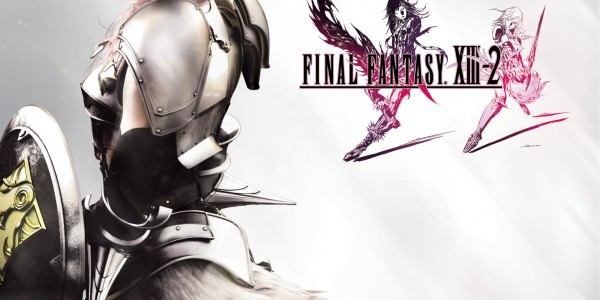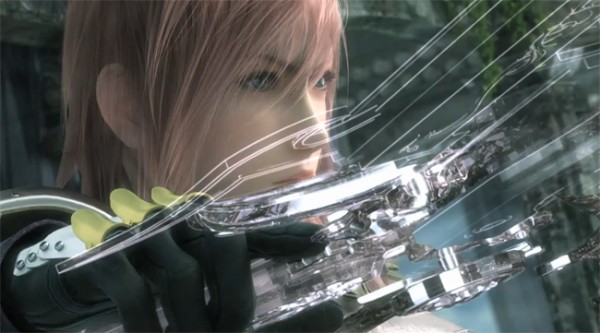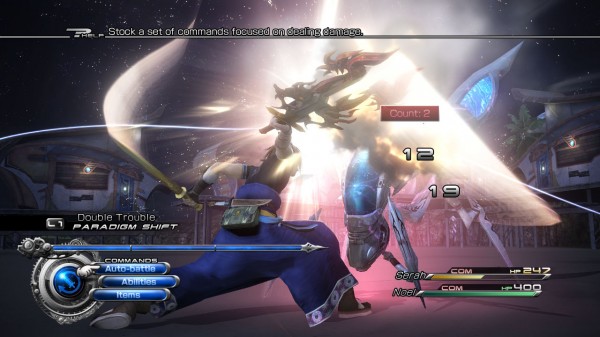Welcome back to the world of cringe-worthy dialogue, unlikeable characters, and needlessly complex plot points. With this latest installment, Square Enix has made a concerted effort to Final Fantasy XIII-2‘s mechanics from a forward-thinking point of view while simultaneously taking the narrative structure in an even more melodramatic direction. This doesn’t alway spell disaster, but when a game steeps in its fantastical world of chocobos, moogles, and crystalline structures, that imbalance becomes far more pronounced. In addition, the aforementioned effort to develop the Final Fantasy brand into something more modern falls flat, leading to a sequel that fails to improve upon its predecessor, then takes a step back.
After an overly bombastic opening cutscene in which Lightning makes her reappearance and fends off the “purple-doo”, the plot moves back in time to introduce Serah, Lightning’s sister and one of the main protagonists. That’s right, as if the l’Cie/fal’Cie class distinction from Final Fantasy XIII weren’t confusing enough, this sequel introduces paradoxes and time travel in an attempt to expand the scope of the game’s story, much like Chrono Trigger. Unlike that RPG classic, Final Fantasy XIII-2 is too concerned with lengthy explanations to highlight the inherent fascination that often comes with those sci-fi elements. Making things worse are the numerous sappy moments that attempt to illicit an emotional response from the player. The worst way to go about that is to include contrived dialogue, and Final Fantasy XIII-2 has that in spades.
These narrative flaws aren’t entirely new, as they made an appearance to some extent in Final Fantasy XIII. Luckily that game’s saving grace was its combat, which acted as a pseudo-strategy/turn-based RPG system unlike most other titles on the market. It returns in Final Fantasy XIII-2 alongside some fairly drastic changes to the game’s mechanics. Now that statement may sound enticing, and it does show a certain willingness on Square Enix’s part to think outside the box. But then those changes show up in the game and a downward spiral occurs.
First, random encounters return. You know, the incredibly dated RPG mechanic that was chased out of popularity two Final Fantasy’s ago. Players are provided the chance to escape battles on occasion and preemptive strikes are made easier with the addition of a dial that pops up with each encounter. I suppose this is meant to put a modern spin on the turn-based RPG trope, but it becomes annoying in a matter of an hour or two. Then there are the live trigger sequences which act as dialogue trees. All the dialogue choices are rather meaningless and serve to expand on a story that was already meandering to begin with.
The list goes on and on, from the simplistic and monotonous puzzles between dimensions to the “Cinematic Action” quick-time events. The most alarming part about these newly implemented systems is how nearly all of them manage to make the game worse. Final Fantasy XIII-2 tries to do too much, which comes as a surprise considering the previous entry in the series departed radically from expectations.
Ultimately, it highlights one of the most underrated design elements out there: restraint. Sometimes doing too much can be seen as an admirable flaw that actually gives a game a certain unexplainable or irrational appeal, but that’s a dangerously fine line. Final Fantasy XIII-2 is a prime example of when a collection of mediocre game mechanics add up to an increasingly unsatisfactory experience. Think of it as “the sum is lesser than the parts.”
In a world of sequels that only marginally improve upon their predecessors, it becomes easy to make rash decisions and go to extremes. This is exactly what leads to Final Fantasy XIII-2‘s downfall. Final Fantasy XIII laid the groundwork for an impressive follow-up, and instead of recognizing that, Square Enix opted to take multiple, unwarranted risks; and risks don’t always pay off.




















